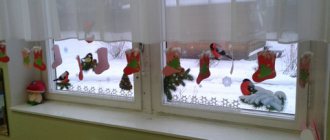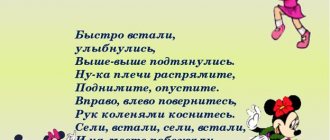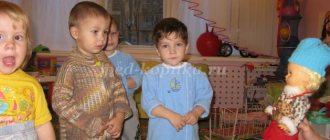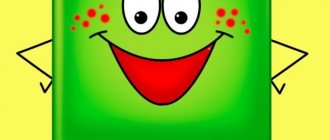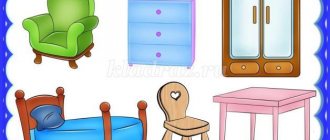Outline of a drawing lesson in the second junior group “Beautiful clothes for Tanya’s doll”
Olga Malgina
Outline of a drawing lesson in the second junior group “Beautiful clothes for Tanya’s doll”
Admiring is an emotion that arises from the ability to highlight the presence or absence of “ beauty ”
in an object, event, phenomenon. Admiration determines the beginning of an aesthetic relationship to reality.
1. Learn to highlight color as a sign of beauty in items of clothing .
of clothing in children’s speech .
3. Continue to ensure timely saturation of the brush bristles with paint .
4. Continue to attract interest in the continuous painting of clothing by applying sweeping strokes.
1. Admiring children's clothes .
Goal: To learn to identify and name color as a sign of beauty in items of clothing .
2. Didactic game: “Dress the doll ”
.
Goal: Clarify and activate the name of clothing .
1. Tanya doll (made of paper)
.
5. Clothing (cut from album sheets)
.
Drawing lesson “Clothes for a doll”
Oleskova Raisa Anatolyevna
Drawing lesson “Clothes for a doll”
Drawing notes.
Decorative drawing. "Clothes for a doll."
Teach children to make a pattern from familiar elements (stripes, dots, circles). Develop creativity, aesthetic perception, imagination. To instill in children a friendly attitude towards the toy (doll, the desire to please it. Teach them to show attention and care for the doll, the desire to decorate clothes for it.
Materials.
Dresses and shirts cut out of white paper, paints, brushes, jars of water, napkins (for each child).
Progress of the lesson.
There is a cry behind the door.
Educator.
What happened there? I'll go have a look. (brings a doll into the group). What happend to you? Why are you crying?
Doll.
Hello children! My name is Masha. I was getting ready to go on a visit and wanted to give clothes to my friends, but they were ugly. (takes dresses and shirts out of her purse and shows them to the children).
Educator.
Don’t cry Masha, the guys and I will help you decorate your clothes. Guys, can we help the doll Masha? (answers).
Show the children dresses and shirts cut out of white paper, explain that they need to be decorated with patterns. Invite the children to remember the elements of the pattern (leaves, rings, dots, lines, squares, etc., show them at the board, think about how they will decorate the clothes.
Look at all the ready-made drawings and, together with the children, choose the most beautiful ones.
Photo report. Cognition lesson in the junior group “Clothing” Photo report. Cognition lesson in the younger group on the topic: “Clothing” Objectives: To form in preschoolers the concept of the general word “Clothing”.
Individual speech therapy lesson on the topic “Clothing. Automation of sound [Ш] in words and sentences” Goal: Development of phonemic perception, dialogical and coherent speech in children. Objectives: Expand and activate the vocabulary on the topic. Specify.
Integrated lesson “Wrappers-clothing for candies” Topic: “Wrappers-clothing for candies” Program content: • Develop decorative creativity in children. • Learn to create patterns based on motifs.
Progress of the lesson:
Kids are playing. Suddenly, crying is heard outside the door.
Educator: What's that noise? Who's that crying outside the door? I'll go and have a look. (Introduces a large doll into the group , which carries paper dolls in the car (according to the number of children)
Educator: Hello. What is your name?
Doll: Hello. I'm Katya.
Educator: Why are you crying, Katya?
Doll: The squirrel invited me to the squirrels’ birthday party. I wanted to give them dolls in beautiful outfits , but I didn’t have time to decorate all the dresses (The teacher takes silhouettes of dresses from her bag and shows them to the children)
.
(The doll is crying)
.
Educator: Don’t cry, now our children will help you. (Puts the doll on a chair)
.
Guys, what can we do to help?
Children: decorate dresses .
Educator: How smart you are. Come on guys, before we start our work, you and I will warm up.
(The teacher pronounces the text and performs the movements, and the children imitate him, finishing words and phrases)
There is a Katya doll in the closet. Stand up, move your hands from above
Sweatshirts, sundresses, dresses along the body.
There is a coat, two pairs of trousers, leaning forward, movements with palms
Bloomers for walking. along the legs from top to bottom.
Lots of blouses exactly, hardly Stand up, hands forward,
They hang in Katya's closet. alternate movement up and down.
Put these things on, Sit down, spread your arms to the sides.
And they call it clothes . Stand up, put your hands down.
Educator: What a great fellow you are, you have warmed up well, now let’s go back to our desks and start working.
Educator: I will now give you dresses and dolls. We will decorate the dress with colored pencils. Look how I decorated the dresses (sample display)
.
What did I draw on the dress ?
Educator: Yes. I drew rings on the sleeves , on top, in the middle, and at the bottom of the dress. I decorated the entire dress.
What color are the rings? (Points to the silhouettes of dresses with rings: red - blue ; yellow - green; red - yellow ; blue - yellow)
Children: Red , blue, yellow, green.
Educator: How will you draw ?
Children: Colored pencils
Educator: Now take a pencil in your hand and draw rings in the air. Practice. To make the dress beautiful and the rings to be visible, you need to press well on the pencil. Now choose what color your rings will be and start decorating your dresses. The dolls will watch you draw (if necessary, the teacher approaches the children and helps)
.
After finishing the drawing, the doll praises the children .
Educator: Take the dolls that are lying on your tables and put dresses on them.
Educator: Well done, children. Katya thanks you. She really liked the dresses. They became beautiful and elegant . What did you draw on the dresses ? (rings)
.
What colour? (
red , blue, yellow, green) . Do you think the baby squirrels will be happy with such a gift? Did you like decorating dresses yourself?
Let's put your dolls in the car (children come up to the car and put the dolls)
.
Educator: And as a farewell, doll Katya wants to treat you with gifts (takes out “Mushroom”
, treats children).
The doll says goodbye, leaves the group , driving the car.
Abstract of the OD “Winter Clothes and Shoes” on familiarization with the outside world in the first junior group “Winter Clothes and Shoes”. OD summary for familiarization with the outside world in the first junior group Goal: To promote the ability to classify.
GCD summary for the application “Beautiful Napkin” in the second junior group. GCD summary for artistic and aesthetic development (applique) “Beautiful Napkin” in the second junior group. Completed by Kosova L. E.
Abstract of the educational method for modeling in the junior group “Beautiful bird based on the Dymkovo toy” April. 1 week Notes on sculpting in the junior group “Beautiful Bird” (Based on the Dymkovo toy) Program content: learn to sculpt an object. Summary of GCD in the second junior group on the topic “Clothing”. LESSON SUMMARY on applique using ready-made forms (stickers) and drawing elements “Beautiful tablecloth” in the junior group LESSON SUMMARY ON APPLIQUE USING READY-made FORMS (STICKERS) AND DRAWING ELEMENTS “BEAUTIFUL TABLECLOTH” IN YOUNGER GROUP OBJECTIVES. Summary of the drawing lesson “Snowy Street” in the junior group Topic: “Snowy Street” Educational areas: cognitive, artistic-aesthetic, speech. Objectives: introduce the poem. Summary of a drawing lesson “Pattern on a mitten” in the junior group Topic: “Pattern on a mitten” Educational areas: cognitive, artistic and aesthetic, speech. Objectives: to introduce this work;.
Source

